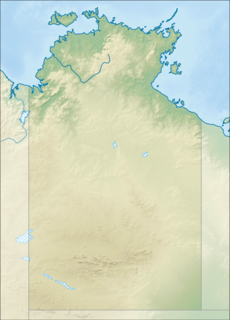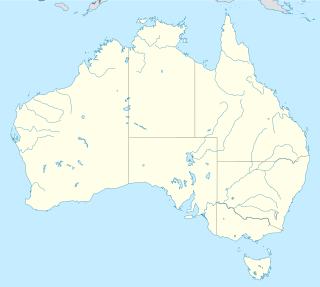Related Research Articles
The Kaurna people are a group of Indigenous Australians whose traditional lands include the Adelaide Plains of South Australia. Pronunciation of the word "Kaurna" varies slightly by the background and origin of the speaker; the most common is English, sometimes, native [ɡ̊auɳa] or, less often,. They were known as the Adelaide tribe by the early settlers. Kaurna culture and language were almost completely destroyed within a few decades of the European settlement of South Australia in 1836. However, extensive documentation by early missionaries and other researchers has enabled a modern revival of both language and culture.

The Ngarrindjeri people are the traditional Aboriginal Australian people of the lower Murray River, western Fleurieu Peninsula, and the Coorong of the southern-central area of the state of South Australia. The term ngarrindjeri means "belonging to men", and refers to a "tribal constellation". The Ngarrindjeri actually comprised several distinct if closely related tribal groups, including the Jarildekald, Tanganekald, Meintangk and Ramindjeri, who began to form a unified cultural bloc after remnants of each separate community congregated at Raukkan, South Australia.

The Pitjantjatjara are an Aboriginal people of the Central Australian desert. They are closely related to the Yankunytjatjara and Ngaanyatjarra and their languages are, to a large extent, mutually intelligible.
Aṉangu is the name used by members of several central Australian Aboriginal groups, roughly approximate to the Western Desert cultural bloc, to describe themselves. The term, which embraces several distinct "tribes", is accurately spelled "Aṉangu" and pronounced with the stress on the first syllable: [ˈaɳaŋʊ].
Ramindjeri were an indigenous Australian people forming part of the Kukabrak grouping now otherwise known as the Ngarrindjeri) people. They were the most westerly Ngarrindjeri, living in the area around Encounter Bay and Goolwa in southern South Australia, including Victor Harbor and Port Elliot. In modern native title actions a much more extensive territory has been claimed.

The Maralinga Tjarutja is the corporation representing the traditional Anangu owners of the remote western areas of South Australia known as the Maralinga Tjarutja lands. It is one of the four regions local government areas of South Australia classified as an Aboriginal Council (AC) and not incorporated within a local government area. This indigenous Australian people whose historic rights over the area have been officially recognised belongs to the southern branch of the Pitjantjatjara people. They have a community centre at Oak Valley, 520 miles NW of Ceduna, and close historical and kinship links with the Yalata 350km south, and the Pila Nguru centre of Tjuntjuntjara 370km to their west.

Musgrave Ranges is a mountain range in Central Australia, straddling the boundary of South Australia and the Northern Territory, extending into Western Australia. It is between the Great Victoria Desert to the south and the Gibson Desert to the north. They have a length of 210 kilometres (130 mi) and many peaks that have a height of more than 1,100 metres (3,600 ft), the highest being Mount Woodroffe at 1,435 metres (4,708 ft).

Matthew Moorhouse was an English pioneer in Australia, pastoralist, politician, and Protector of Aborigines in South Australia. He led the Rufus River massacre, where he and his men murdered 30-40 Maraura men, women and children.

Aṉangu Pitjantjatjara Yankunytjatjara is a large, sparsely populated local government area (LGA) for Aboriginal Australians, located in the remote north west of South Australia. It consists of the Pitjantjatjara, Yankunytjatjara and Ngaanyatjarra aṉangu, and has a population of around 2300 people.
Charles Duguid was a Scottish-born medical practitioner, social reformer, Presbyterian lay leader and Aboriginal rights campaigner who lived in Adelaide, South Australia for most of his adult life, and recorded his experience working among the Aboriginal Australians in a number of books. He founded the Ernabella mission station in the far north of South Australia. The Pitjantjatjara people gave him the honorific Tjilpi, meaning "respected old man". He and his wife Phyllis Duguid, also an Aboriginal rights campaigner as well as women's rights activist, led much of the work on improving the lives of Aborigines in South Australia in the mid-twentieth century.

Indulkana is an Aboriginal community in the Anangu Pitjantjatjara Yankunytjatjara Lands in South Australia, comprising one of the six main communities on "The Lands". At the 2006 census, Indulkana had a population of 315.

Mintabie is an opal mining community in the Anangu Pitjantjatjara Yankunytjatjara in South Australia. It was unique in comparison to other communities situated in the APY Lands, in that its residents were largely not of Aboriginal Australian origin, and the land had been leased to the Government of South Australia for opal mining purposes since the 1980s.

The Anangu Pitjantjatjara Yankunytjatjara Land Rights Act 1981 (APYLRA) grants certain land and other rights to the Anangu Pitjantjatjara Yankunytjatjara in South Australia. It began its life as the Pitjantjatjara Land Rights Act and commenced operation on 2 October 1981. Its long name title is "An Act to provide for the vesting of title to certain lands in the people known as Anangu Pitjantjatjara Yankunytjatjara; and for other purposes". The Act has since had several amendments, the latest in 2017.
Land councils, also known as Aboriginal land councils, or land and sea councils, are Australian community organisations, generally organised by region, that are commonly formed to represent the Indigenous Australians who occupied their particular region before the arrival of European settlers. They have historically advocated for recognition of traditional land rights, and also for the rights of Indigenous people in other areas such as equal wages and adequate housing.
The Bungandidj people are Indigenous Australians from the Mount Gambier region in south-eastern South Australia, and also in western Victoria. Bungandidj was historically frequently rendered as Boandik or Booandik.
An Aboriginal reserve, also called simply reserve, was a government-run settlement for Aboriginal Australians, created under various state and federal legislation. Along with missions and other institutions, they were used from the 19th century to the 1960s to keep Aboriginal people separate from the white Australian population, for various reasons perceived by the government of the day. The Aboriginal reserve laws gave governments much power over all aspects of Aboriginal people’s lives.

Yunyarinyi is an Aboriginal community on the Aṉangu Pitjantjatjara Yankunytjatjara Lands in South Australia. It is located about 45 kilometres (28 mi) south of the border with the Northern Territory, and 320 km (200 mi) south of Alice Springs. It is 40 km from the larger community of Pukatja, where most of the services are located.
The Rufus River Massacre was a massacre of 30–40 Aboriginal people that took place in 1841 along the Rufus River, in the Central Murray region, after two consecutive encounters with "overlanders" on the recently opened overland stock route, which followed an old Aboriginal route. The massacre occurred after an official party, including Protector of Aborigines, Matthew Moorhouse, along with police, was sent out by the Governor of South Australia, George Grey.

Raukkan is an Australian Aboriginal community situated on the south-eastern shore of Lake Alexandrina in the locality of Narrung, 80 kilometres (50 mi) southeast of the centre of South Australia's capital, Adelaide. Raukkan is "regarded as the home and heartland of Ngarrindjeri country."

The Avenue Range Station massacre was the murder of a group of Aboriginal Australians by white settlers during the Australian frontier wars. It occurred in about September 1848 at Avenue Range, a sheep station in the southeast of the Colony of South Australia.
References
- ↑ "Transcript of the South Australia Act, 1834" (PDF). Museum of Australian Democracy at Old Parliament House. 4 & 5 Will. IV c. 95. Retrieved 9 June 2018.
- ↑ William the Fourth (19 February 1836), Letters patent establishing the Province of South Australia (PDF), retrieved 3 January 2016
- ↑ "Proclamation of South Australia". Documenting a Democracy. Museum of Australian Democracy. Retrieved 3 January 2016.
- 1 2 3 4 "Protector of Aborigines Out Letter-Book: 7 December 8th, 1892 to September 4th, 1906: Including List of Addressees, And Subject Index" (PDF). Retrieved 18 November 2019.Cite journal requires
|journal=(help) - 1 2 Foster R. (2000), "'endless trouble and agitation': Aboriginal activism in the Protectionist era", Journal of the Historical Society of South Australia, 28: 15-27.
- ↑ "Seventy Years a Colonist". The Advertiser . 3 July 1909. p. 8. Retrieved 3 January 2016– via National Library of Australia.
- ↑ 'Moorhouse, Matthew (1813–1876)', Australian Dictionary of Biography, National Centre of Biography, Australian National University, http://adb.anu.edu.au/biography/moorhouse-matthew-4239/text6843, published first in hardcopy 1974, accessed online 4 January 2016.
- ↑ "Out of the Silence The History and Memory of South Australia's Frontier Wars". Flinders Ranges Research. Retrieved 27 June 2018.
- ↑ "The Maria Massacre". Graham Journay. Retrieved 27 June 2018.
- ↑ Burke H., Roberts A., Morrison M., Sullivan V., The River Murray and Mallee Aboriginal Corporation (2016), "The space of conflict: Aboriginal/European interactions and frontier violence on the western Central Murray, South Australia, 1830–41", Aboriginal History , 40: 145-179.
- ↑ According to the ethnologist and anthropologist Norman Tindale, Wattatonga was the name used by the neighbouring Bungandidj people to refer to the Tanganekald people.
- ↑ Foster, Robert; Hosking, Rick; Nettelbeck, Amanda (2001). Fatal Collisions: The South Australian Frontier and the Violence of Memory. Kent Town, South Australia: Wakefield Press. pp. 74–93. ISBN 978-1-86254-533-5.
- ↑ Christina Smith, pp62, The Booandik Tribe of South Australian Aborigines: A Sketch of Their Habits, Customs, Legends, and Language , Spiller, 1880
- ↑ "Waterloo Bay, Elliston, Eyre Peninsula". Colonial Frontier Massacres in Central and Eastern Australia 1788–1930. University of Newcastle. Retrieved 13 August 2018.
- ↑ Foster, Robert; Hosking, Rick; Nettelbeck, Amanda (2001). Fatal Collisions: The South Australian Frontier and the Violence of Memory. Kent Town, South Australia: Wakefield Press. pp. 44–73. ISBN 978-1-86254-533-5.
- ↑ Edwards, W. H. "Duguid, Charles (1884 - 1986)". Australian Dictionary of Biography. Originally published in Volume 17 of the ADB (Melbourne University Press, 2007, pp. 338-340). Retrieved 18 November 2019.
- 1 2 "Human Rights and Equal Opportunity Commission: Bringing them Home: Part 2: 8 South Australia". 1997. Retrieved 25 November 2016– via AustLII.
- ↑ "No stolen generation: Australian Govt". The 7.30 Report (ABC). 3 April 2000. Archived from the original on 7 September 2016. Retrieved 24 November 2016.
- ↑ "Anangu Pitjantjatjara Yankunytjatjara Land Rights Act 1981 (SA)" . Retrieved 5 January 2015.
- ↑ "Bloodlines: The Nicholls Family". MessageStick. ABC. 19 September 2010. Archived from the original on 12 January 2016. Retrieved 5 January 2016.
- ↑ "Kaurna People". Adelaidia. Retrieved 27 June 2018.